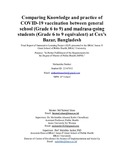| dc.contributor.advisor | Chowdhury, Mohiuddin Ahsanul Kabir | |
| dc.contributor.advisor | Sarker, Malabika | |
| dc.contributor.author | Neeher, Nishantika | |
| dc.date.accessioned | 2023-07-18T09:16:15Z | |
| dc.date.available | 2023-07-18T09:16:15Z | |
| dc.date.copyright | 2023 | |
| dc.date.issued | 2023 | |
| dc.identifier.other | ID 22167012 | |
| dc.identifier.uri | http://hdl.handle.net/10361/18897 | |
| dc.description | This project report is submitted in partial fulfillment of the requirements for the degree of Master of Public Health (MPH), 2023. | en_US |
| dc.description | Cataloged from the PDF version of the project report. | |
| dc.description | Includes bibliographical references (pages 29-37). | |
| dc.description.abstract | Background
Schools and madrasas are regarded as high-risk locations for COVID-19 epidemics due to the
crowded campus atmosphere, high movement, and constrained space. Therefore, vaccination is
believed to be an essential tactic that can significantly reduce the occurrence and spread of this
deadly infectious disease. However, there may be variations between a madrasa and a school
regarding students’ desire to receive the COVID-19 vaccination. Therefore, a study comparing
knowledge and practice of COVID-19 vaccination between general school and madrasa-going
students is essential to improve vaccine coverage and prevent a future outbreak.
Methods
A cross-sectional quantitative survey was conducted on students from six schools and six
madrasas in Bangladesh. A semi-structured and self-reported questionnaire containing informed
consent, four sections containing the socio-demographics section, the impact of COVID section,
knowledge about COVID vaccine section, and uptake of COVID vaccine was used. Multiple
logistic regression was performed to determine the variables affecting the uptake of COVID-19
vaccinations.
Results
A total of 2361 respondents were included in the final analysis, out of whom 1550 (65.65%)
were school students and 811 (34.35%) were from the madrasa. The average age of students was
13.74±1.41 (SD), and more than half were females (64.00%). Both students from school and
madrasa had adequate knowledge about the COVID-19 vaccine, and the proportion of madrasa
students with correct answers was higher than that of school students. The common source of
knowledge for school students was school; for madrasa students, it was mass media. There was
more than 95% vaccine uptake for both institutions, and the primary reason for taking the
vaccine was the perception that the vaccine was safe. Socio-demographic factors like age, family
size, and location had a significant association with vaccine uptake.
Conclusions
The findings reflect that there is no significant difference in uptake of the COVID vaccine
between schools and madrasa. The proportion of madrasa students was higher than school
students when asked about knowledge. | en_US |
| dc.description.statementofresponsibility | Nishantika Neeher | |
| dc.format.extent | 37 pages | |
| dc.language.iso | en | en_US |
| dc.publisher | Brac University | en_US |
| dc.rights | Brac University project reports are protected by copyright. They may be viewed from this source for any purpose, but reproduction or distribution in any format is prohibited without written permission. | |
| dc.subject | School | en_US |
| dc.subject | Madrasa | en_US |
| dc.subject | Covid-19 | en_US |
| dc.subject | Vaccination | en_US |
| dc.subject.lcsh | COVID-19 (Disease)--Vaccination | |
| dc.title | Comparing knowledge and practice of Covid-19 vaccination between general school (Grade 6 to 9) and madrasa-going students (Grade 6 to 9 equivalent) at Cox’s Bazar, Bangladesh | en_US |
| dc.type | Project report | en_US |
| dc.contributor.department | James P Grant School of Public Health, Brac University | |
| dc.description.degree | M. Public Health | |

